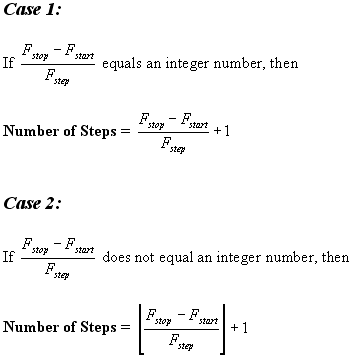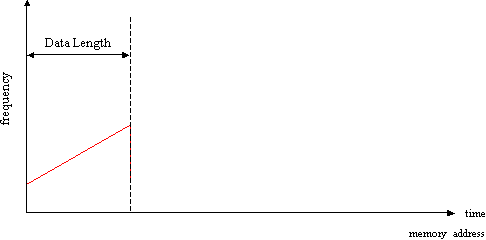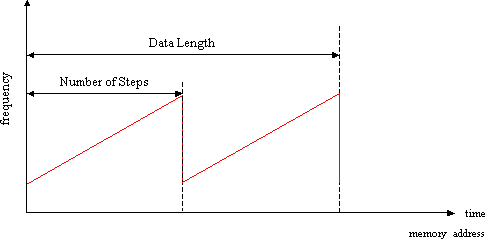Data Length -
Data Length specifies the number of frequencies to output in a chirp. This section will explain some of the parameters of the chirp in relation to the Data Length so that you will have the desired chirp that you want.
As explained in the previous Parameters section, a chirp is comprised of the Start Frequency, the Step Frequency and the Stop Frequency. It is important to remember that only the Start Frequency and the Step Frequency is guaranteed. The DSM will always start a chirp at the Start Frequency and will always output the next frequency by adding the Step Frequency to the previous frequency. What is not guaranteed is the Stop Frequency. The DSM can only guarantee that the maximum frequency output by the DSM will not exceed the Stop Frequency but whether or not the maximum frequency is equal to the Stop frequency depends on your Start and Step frequencies.
For example, if you set the Start Frequency to 100 MHz, your Step Frequency to 2 MHz and your Stop Frequency to 300 MHz then the maximum frequency output will be 300 MHz (Start Freq + Step Freq*100). But if you had instead chose your Stop Frequency as 301 MHz then the maximum frequency output will still be 300 MHz since the combination of your Start Frequency and your Step Frequency makes it impossible to output a frequency of 301 MHz.
As stated before Data Length is the number of frequencies that will be output. This parameter is also guaranteed meaning that if you set Data Length as 64,000 then 64,000 frequencies will be in the chirp no matter what you set as Start Frequency, Stop Frequency and Step Frequency.
Calculating Number of Frequency Steps
The number of steps in your chirp does not necessarily have to equal the Data Length. The number of steps in your chirp is calculated from the Start Frequency, the Stop Frequency and the Step Frequency as follows:

Data Length and Number of Frequency Steps
There are several combinations in which you can have the number of frequency steps and the Data Length and they are as follows:
Case A: Data Length = Number of Steps

This would be the most common case where your Data Length is equal to the number of steps.
Case B: Data Length < Number of Steps

In this case, the Data Length will truncate your desired chirp so that you will not reach the Stop frequency.
Case C: Data Length > Number of Steps

For this case, there will be one complete chirp of your desired frequencies and when the DSM reaches the Stop Frequency it will restart at the Start Frequency and chirp until the Data Length is reached.
Case D: Data Length = (Number of Steps)*m, where m > 1

The DSM will output several complete cycles of the chirp depending on how long your Data Length is. In Free Run mode, you would not be able to tell a difference between this and Case A.
Case E: Data Length = (Number of Steps)*m, where m > 1

This is similar to Case C except the DSM will output more than one complete cycle of your chirp. After the last complete chirp cycle, the DSM will output part of the chirp until it reaches the Data Length.